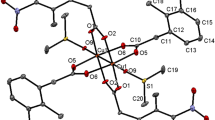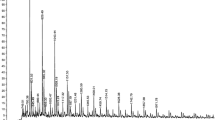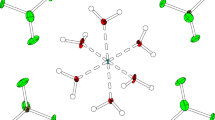Abstract
A polychelate with poly(dl-aspartic acid) was prepared in order to study the influence of the polymer ligands on the copper(II) acetate monohydrate. This compound was characterized by elemental analysis, magnetic susceptibility measurements, spectroscopy and thermal analysis. It is suggested that in the unit Cu2(acetate)4 the breakage of two acetate groups occurs by the effect of polymer ligand group coordination. It coordinates through a carboxylate group, keeping the water molecules coordinated to CuII. A magnetic moment of the polychelate is observed which presents a value of 1.74 M.B, which corresponds to uncorrelated Cu2+ (S = 1/2) spins, separated by large Cu–Cu distances.
According to the suggested structure, PM3 semi-empirical calculations of the polychelate of CuII were done.
Similar content being viewed by others
References
van Nieckerk J.N. and Schoening F.R.L. (1953). Acta Cryst. 6: 227
Kato M., Jonassen H.B. and Fanning J.C. (1964). Chem. Rev. 64: 99
Hay P.J., Thibeault J.c. and Hoffmann R. (1975). J. Am. Chem. Soc. 97: 4884
D.M.L. Goodgame, N.H. Hill, D.F. Marsham, A.C. Skapski, M.L. Smart and P.G.H. Troughton, Chem. Commun, 629 (1969).
Uekusa H., Ohba S. and Saito Y. (1989). Acta Cryist C45: 377
Smith G., Kennard C.H.L. and Byriel K.A. (1991). Polyhedron 10(8): 873
Ye B., Chen X., Xue F., Ji L. and Mak T.C.W. (2000). Inorg. Chim. Acta 299: 1
Kozlevcar B., Leban I., Turel I., Segedin P., Petric M., Pohleven F., White A.J.P., Williams D.J. and Sieler J. (1999). Polyhedron 18: 755
Sundberg M.R., Uggla R. and Melník M. (1996). Polyhedron 15(7): 1157
Perlepes S., Libby E., Streib W.E., Folting K. and Christou G. (1992). Polyhedron 11(8): 923
Henriksson H.Á. (1977). Acta. Cryst. B33: 1947
Abuhijleh L. (1992). Inorg. Chim. Acta 194: 9
Abuhijleh L. (1996). Polyhedron 15: 285
Seguel G.V., Rivas B.L. and Novas C. (2005). J. Chil. Chem. Soc. 50(1): 401
Seguel G.V., Rivas B.L. and Novas C. (2006). J. Chil. Chem. Soc. 51(1): 401
V. Mohan Rao, D.N. Sathyanayana and H. Manohar, J. Chem. Soc. Dalton Trans., 2167 (1983).
Bleaney B. and Bowers K.D. (1952). Proc. R. Soc. London A 214: 451
Author information
Authors and Affiliations
Corresponding author
Rights and permissions
About this article
Cite this article
Seguel, G.V., Rivas, B.L., Moreno, Y. et al. Poly(dl-aspartic acid) and copper(II) acetate monohydrate interactions. Transition Met Chem 32, 1106–1109 (2007). https://doi.org/10.1007/s11243-007-0293-4
Received:
Accepted:
Published:
Issue Date:
DOI: https://doi.org/10.1007/s11243-007-0293-4




